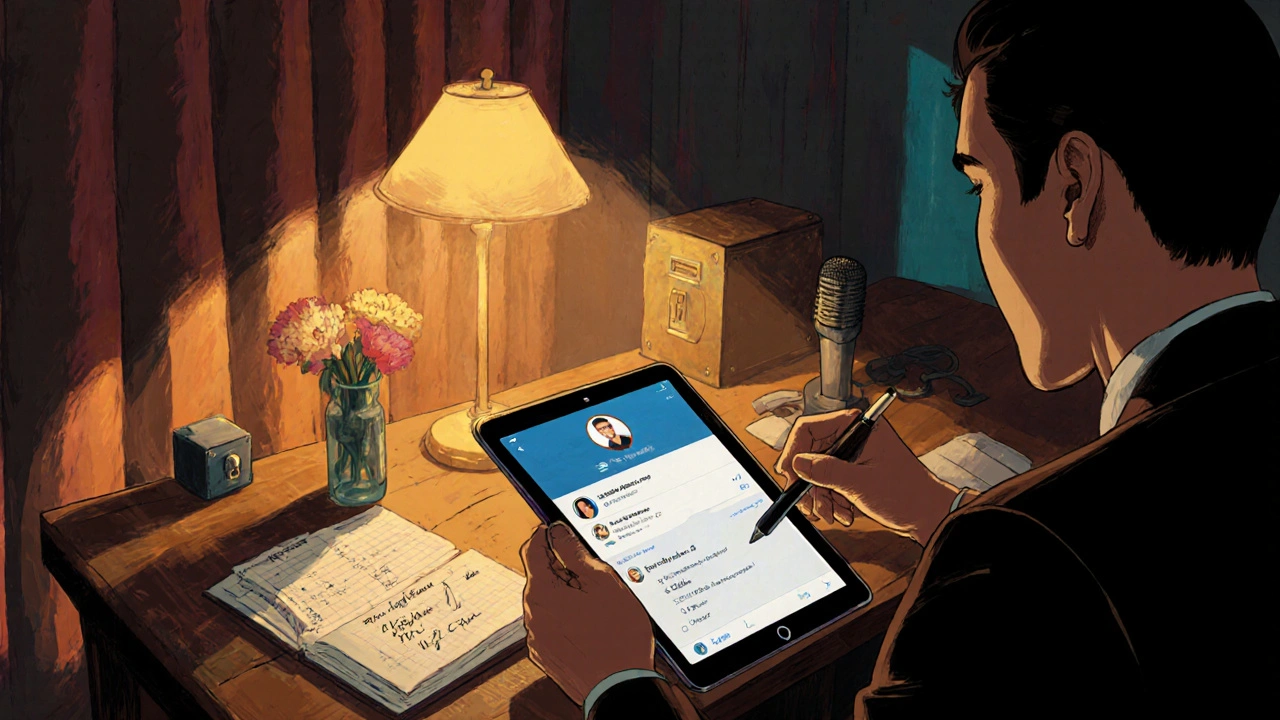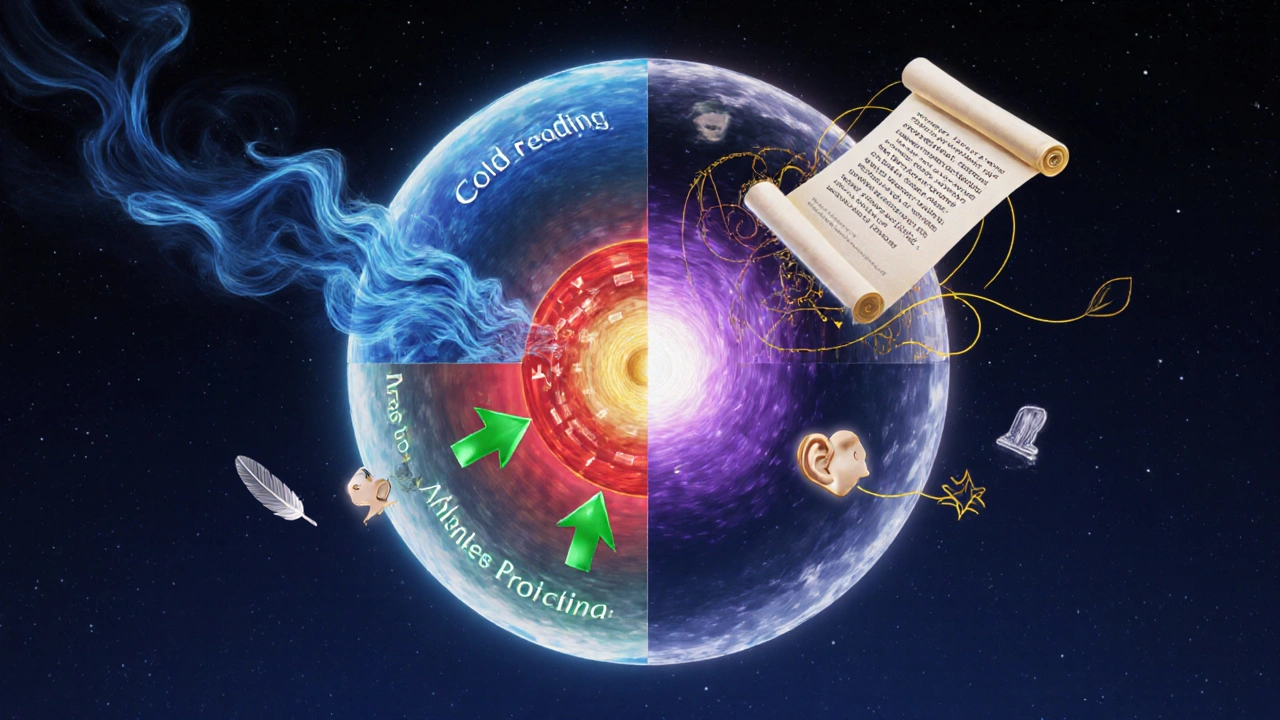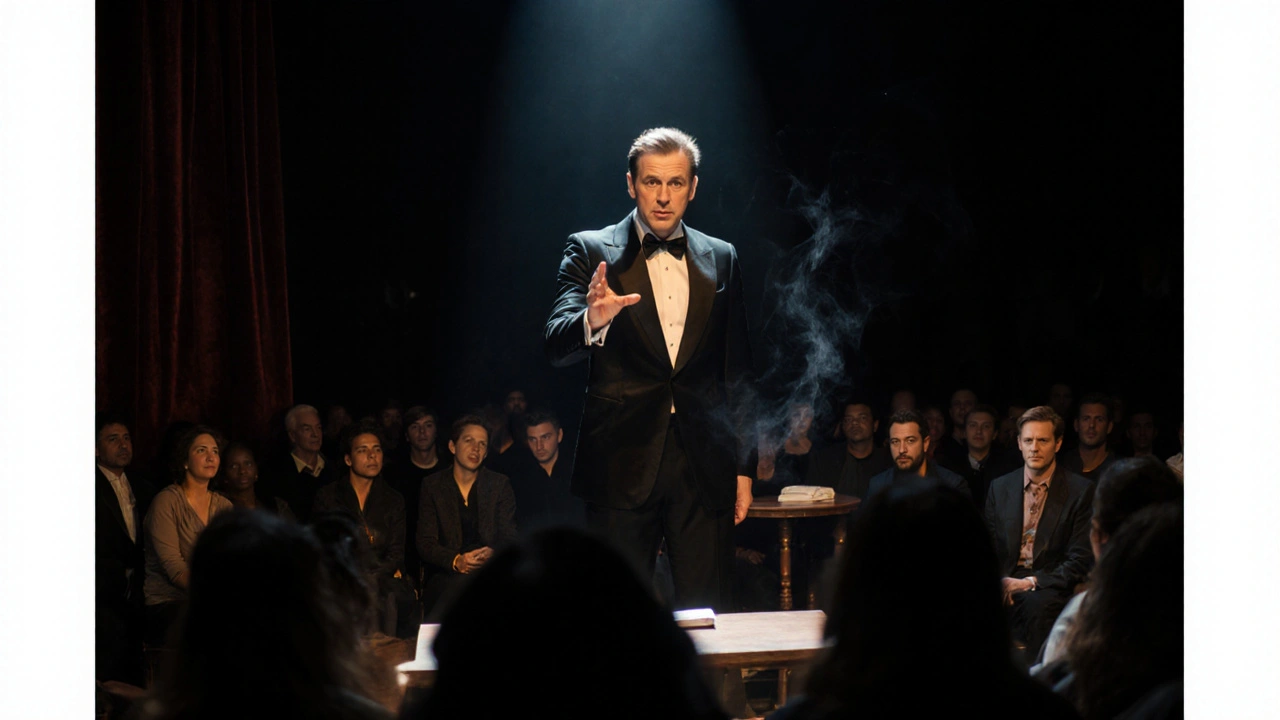Mentalism Technique Checker
Cold Reading
Making general observations that seem personal using probability and pattern recognition.
PsychologyHot Reading
Using pre-gathered personal information to create seemingly impossible predictions.
Information GatheringPsychological Forcing
Subtly guiding choices to predetermined outcomes using cognitive biases.
Cognitive BiasMisdirection
Diverting attention away from the methods used to create illusions.
Attention ControlSuggestibility
Increasing openness to subtle influences and cues that affect decisions.
Behavioral InfluenceChecklist for Identifying Mentalism Techniques
Click on each item to mark it as observed during a performance:
Analysis Result
Click on checklist items to analyze the performance techniques used.
Ever watched a mentalist a performer who creates the illusion of reading thoughts or foretelling choices and wondered whether they truly glimpse the future? The short answer is no-what looks like prophecy is a blend of psychology, misdirection, and clever preparation. Below we break down the exact tools mentalists use, the science behind why they work, and how you can spot the trick before it happens.
Quick Take
- Mentally predicting outcomes is an illusion built on cold reading, hot reading, and psychological forcing.
- Audience mindset, suggestion, and memory tricks amplify the effect.
- A simple checklist can help you see through most “future‑telling” acts.
- Comparison table shows strengths and weaknesses of each core technique.
- FAQs cover common doubts about mentalism and genuine intuition.
How Mentalists Simulate Future Prediction
Most mentalism acts follow a three‑part formula: gather data, influence choice, and reveal a pre‑written “prediction.” The data‑gathering step often happens without the audience realizing it. Whether it’s a quick chat before the show, a hidden camera, or a well‑timed question, the performer builds a profile that seems impossible.
Once they have enough clues, they employ psychological forcing-subtly steering a volunteer toward a specific answer while maintaining the illusion of free will. The final reveal is usually a neatly folded paper or a locked box that appears to have been prepared months earlier, but in reality it was set up moments before the climax.
Core Techniques Behind the Illusion
Below are the five most common tools mentalists rely on. Each is a distinct entity that can be defined on its own.
Cold Reading A method of making high‑probability statements that feel personal
Cold reading works because humans love patterns. The performer offers vague observations-"You’ve had a recent change in your career"-that apply to many people. When a spectator nods, the mentalist zeroes in, asking follow‑up questions that appear to be mind‑reading.
Hot Reading Gathering private information about a participant in advance
Hot reading is the opposite of cold reading. The mentalist researches the volunteer beforehand-through social media, public records, or a confederate-so the “prediction” feels impossible. This technique is common in televised specials where the audience is pre‑screened.
Psychological Forcing Guiding a person toward a specific choice without them noticing
Forcing leverages cognitive bias. By framing options in a certain order, using specific words, or even adjusting lighting, the mentalist nudges the subject toward a predetermined answer. The subject believes they made a free choice, while the mentalist already knows the outcome.
Misdirection Diverting audience attention away from the method
The classic magician’s tool, misdirection, is used to hide the mechanics of a trick. While the audience watches a dramatic hand gesture, the mentalist subtly swaps a card, plants a prediction, or activates a hidden device.
Suggestibility Increasing a subject’s openness to influence
Suggestibility is the psychological state where a person is more likely to accept subtle cues. Techniques like “anchoring” (repeating a word) or “priming” (showing related images) make the audience more receptive to the forced choice.

Real‑World Examples That Illustrate the Process
One of the most famous modern mentalists, Derren Brown, combines all five techniques in his TV specials. In the episode “The Secret of Luck,” he appears to predict a random number a volunteer will think of. Behind the scenes, he uses hot reading to learn the volunteer’s birthday, then applies a forced sequence of numbers that statistically favors the chosen one.
Another classic case is the “Prediction in a Locked Box” routine. The performer shows an empty, locked box before the show, then after the volunteer selects a word, the box is opened to reveal a slip of paper matching the choice. The secret usually involves a duplicate box or a quick‑swap during misdirection, not actual foresight.
Spotting the Trick: A Practical Checklist
- Watch for vague statements. If the performer says something that could apply to anyone, they’re likely cold reading.
- Notice pre‑show interactions. Any asked‑for personal info, even casually, may be hot reading material.
- Look for repeated phrasing. Forced language patterns often betray psychological forcing.
- Track eye lines and gestures. Sudden shifts can signal misdirection moments.
- Gauge audience response. Overly enthusiastic nods often indicate the performer has steered the participant.
Apply this checklist during a show, and you’ll catch the sleight of hand before the grand reveal.
Technique Comparison
| Aspect | Cold Reading | Hot Reading | Psychological Forcing |
|---|---|---|---|
| Data Source | General observations, probability | Pre‑collected personal data | Real‑time suggestion cues |
| Preparation Needed | Minimal | Significant (research, confederates) | Medium (scripted language) |
| Risk of Failure | Higher if audience is skeptical | Lower; data already matches | Medium; relies on subtle persuasion |
| Typical Use | Street performances, quick TV bits | TV specials, pre‑screened audiences | Stage routines with “free‑choice” outcomes |
| Ethical Concerns | Generally benign | Privacy issues if data is obtained covertly | Manipulation of perceived free will |
Frequently Asked Questions
Do mentalists actually have psychic abilities?
No. Their feats rely on psychology, pre‑gathered information, and theatrical tricks rather than any supernatural power.
Can anyone learn to perform mentalism?
Yes, with study of cold reading, suggestion techniques, and stagecraft. Beginners often start with simple forced‑choice routines before tackling complex predictions.
Is hot reading illegal?
It isn’t illegal by itself, but gathering private data without consent can violate privacy laws such as GDPR or California’s CCPA.
Why does my brain accept forced choices as free?
Cognitive bias called ‘illusory freedom’ makes people feel autonomous when subtle cues guide their decision, a principle exploited by mentalists.
What’s the biggest mistake beginners make?
Relying on complex scripts instead of mastering timing and misdirection. Simpler tricks executed flawlessly look far more convincing.

Next Steps for the Curious
If you want to test a mentalist’s claim yourself, attend a live show and apply the checklist above. Notice each moment where the performer gathers info or subtly steers choices. After the show, compare what you observed with the final reveal. You’ll quickly see that the so‑called “future” is a well‑rehearsed illusion.
For aspiring performers, start small: practice cold reading on friends, learn basic suggestion phrases, and record yourself to spot misdirection opportunities. As you build confidence, you can experiment with pre‑show hot reading (always get consent) and design a simple “prediction in a sealed envelope” routine.
Remember, the real magic isn’t in predicting tomorrow-it’s in understanding how our minds can be guided, and using that knowledge responsibly on stage.

